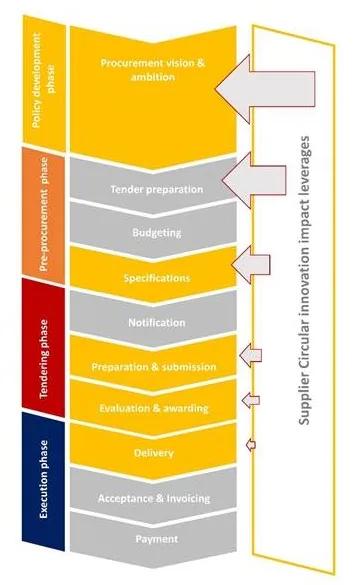Every year, European public authorities spend about 14% of their GDP on public procurement at a local, regional, national and European level. This amounts to more than EUR 1.9 trillion. Governments are moving towards integrating circular principles into their tenders. We, the manufacturing industry, had better make use of this lever. There are lots of opportunities to find here, but also some uncertainties.
One of the Circular Economy Connect Learning Network sessions organised by Sirris and Agoria was exactly about this. We want to share experiences and insights that can help increase your chances of success.
Not always what it seems
Circular public tenders want to stimulate the transition to a more circular economy. This should definitely be applauded. However, the circular economy or circular public contracts are non-existent concepts in public procurement legislation. That makes it a challenge. The legislation does use concepts such as sustainability, environmental friendliness, climate performance, etc. The challenge is to translate each of these concepts into assessable criteria.
Governments and companies alike are currently going through a circular learning process. There is indeed room for movement and interpretation on both fronts. On the one hand, this is a challenge; on the other, it also creates opportunities for circular pioneers.
Crucial phases of public contracts for circular purchasing
Public contracts pass through different creation phases. Depending on the size (i.e. 'euro value') of the contract, more or less formal and also informal steps need to be completed in a fixed order (see diagram below).
The authorities are certainly building up knowledge in circularity, but they do not always succeed in translating it into attractive contracts befitting an adequately broad market offer. The suppliers, for their part, are also acquiring experience and knowledge in circular solutions to meet the challenges they know their customers are facing. These solutions may, however, not always be in line with the needs and intended policies of public authorities.
As both providers of innovative circular products and services and contracting authorities are searching, we see a clear need for the exchange of knowledge and experience. How to find out what the options are: which products and services exist, how to measure or assess circularity or sustainability, how to include the environmental impact of behaviour as an assessment criterion, how to assess the risks associated with new products and/or services, the impact of earning models on the intended criteria ... The needs and circular ambitions of the authorities and the circular innovations and ambitions of the providers should therefore definitely get to know each other. This could bring the new or innovative insights needed to take concrete action.
It is important to make a distinction between large authorities or government organisations, where expertise and staff are available, and smaller municipalities, which do not have the necessary expertise or time.
A challenge for both tenderer and provider is the fact that introducing circularity into tenders is so much more than just a single circular purchase. It involves a variety of aspects - technical, financial, logistics, business model, etc., requiring the involvement and cooperation of the entire value chain and the internal organisation of the actors involved.
Tips & tricks to get started as a company
For almost all aspects, it is important for companies to act proactively on their own initiative: do not wait until the government is ready, be the first to take action. In this way, you can help steer in a certain direction and think about suitable assessment criteria. On the other hand, governments will also be looking for information about the offer. So, as a company, make sure they can find you to increase the chance that your solutions will be on the radar. Searching and being found is a good basis for aligning and possibly adjusting the joint circular goals.
Below are a number of starting points that that may be useful in the dialogue between manufacturing companies and governments.
Procedure
Ask yourself: which step of the procedures creates most value? The answer is obvious: as early in the process as possible. That’s why it is important to be alert to market surveys organised by the governments and to proactively make your offer known to this target group as well. Make sure that your company is found and consulted when a market survey is set up. Spontaneous communication when there is not really a commercial demand is therefore essential.
Informal networking is also important. Participate in information events, pilot projects, studies, experiments, etc. In this way, you will learn how to enhance your company (products and services) and find out how governments deal with this, what is important to them, what trends are emerging, etc.
More generally, it is also important to get an overall idea of the different procurement forms and the specific moments of interaction and negotiation.
Technical specifications
The greatest lever for value creation lies with the person (or team) drawing up the technical specifications. You should therefore find out, through informal contacts or market research, who your customer is within this public service (which department, person, etc.) and what the problem is that needs to be solved. Does your product or service tackle the challenge for the persons providing input for the technical specifications? In the case of a product-service combination, addressing the financial manager is also a must, to ensure that budgets can be reallocated. After all, as-a-service solutions shift CAPEX to OPEX. Also bear in mind that the decision paths for investments or services are quite different. It may be interesting to examine the organisation chart of the contracting authority or government organisation, the policy plan of the specific government and the allocated budgets.
As a company, you can ask authorities about past criteria for circular tenders. Once you have the answer, you will be able to retroactively match these with your proposal, measurement standards and examine the advantages and disadvantages on that basis.
The Green Deal Circular Procurement has drawn up an ambition map for circular purchasers (in governments and businesses) to consider, focusing on one or more strategies. The different strategies that have been identified can be found here. Compare these with your offer and see which alternatives or additions can increase your chances of a better match. Use the ambition map as an entry point to start the dialogue with governments
Refine your offer to the tenderer
Companies need to build in enough flexibility into the offer. Think of:
- shorter (than desired or financially optimal) contract duration
- upgradability of product and service, with possibly changing usage patterns
- different options at the end of the contract (take back, upgrade, purchase, replacement in new contract, ...)
- Demonstrating government involvement in the final life of the product (how will this be achieved, can the government share in the residual value?)
For larger projects, previous actors may also be involved. A solution to stimulate cooperation in such a case may be appointing a 'single point of contact' (or integrator) who facilitates synchronisation between different players and takes care of contacts with the contracting authority. In this case it is also important to start the discussion with the contracting authority on the basis of shared objectives (such as TCO, lifecycle cost, the change from CAPEX to OPEX - for as-a-service solutions - or the reduction of the ecological footprint).
Case: Q-Lite - Municipality of Rotselaar
The municipality of Rotselaar was shocked by the maintenance costs of the LED displays after the initial maintenance contract ended. Six years after purchase, problems and worries emerged. The communications manager had been assigned to find a solution for this problem by the municipal council. He surveyed the market looking for a financially predictable and worry-free solution.
Q-lite produces and markets such LED displays and was one of the companies contacted. Q-lite presented its 'display-as-a-service', which was very much appreciated. Based on the information obtained, the communications officer wrote a technical specification which he passed on to his colleague in charge of procurement. On the basis of this specification, she drew up a tender for a 'Display as a Service'. Three potential suppliers were invited, two of whom submitted a tender: the tender from Q-lite, which met the requirements of the specifications 100 per cent, and that from another company which scored considerably lower on the assessment criteria.
Q-lite presented a solution to the communications manager’s problem and was rewarded for this. The actors in the municipality - the communications officer, purchaser and alderman - went through a learning process and are now more familiar with the product-as-a-service model. Perhaps this will increase the opportunity for other product-service combinations in the future.
Leasons learned
Below are the main lessons learned from our learning network CE Connect on the topic of circular public contracts:
- Engage with the authorities
- Make sure they can find you
- Make sure you know their procedures and especially the informal side of the process, where the real decisions are made!
- Promote your solutions
- Work together: if there are several companies with product-as-a-service, it is easier for the government to specify.
- Set up experiments
Let Sirris support you
Sirris offers companies guidance in circular entrepreneurship, circular product design, the expansion of their network, the development of products and services in function of specific customer segments, etc. One of the working forms are the learning networks. There will be another opportunity to join our learning networks. If you are interested in learning from other companies and projects, let us know and secure your place in our network.
More detailed information on this topic can be found on the Agoria blog via this link.
(Image above: Q-lite)
]]>





